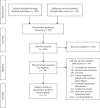The Clinical and Angiographic Outcomes of Postdilation after Percutaneous Coronary Intervention in Patients with Acute Coronary Syndrome: A Systematic Review and Meta-Analysis
- PMID: 33935601
- PMCID: PMC8055432
- DOI: 10.1155/2021/6699812
The Clinical and Angiographic Outcomes of Postdilation after Percutaneous Coronary Intervention in Patients with Acute Coronary Syndrome: A Systematic Review and Meta-Analysis
Abstract
Objective: The effect of postdilation in patients with acute coronary syndrome is still controversial. This meta-analysis aims to analyze the clinical and angiographic outcomes of postdilation after percutaneous coronary intervention in patients with acute coronary syndrome.
Methods: PubMed, Embase, the Cochrane Library, Web of Science, CNKI, and Wangfang databases were searched from inception to August 30, 2020. Eligible studies from acute coronary syndrome patients treated with postdilation were included. The primary clinical outcome was major adverse cardiovascular events (MACE), the secondary clinical outcomes comprised all-cause death, stent thrombosis, myocardial infarction, and target vessel revascularization, and the angiographic outcomes were no reflow and slow reflow.
Results: 11 studies met inclusion criteria. In clinical outcomes, our pooled analysis demonstrated that the postdilation had a tendency of decreasing MACE (OR = 0.67, 95% CI 0.45-1.00; P = 0.05) but significantly increased all-cause death (OR = 1.49, 95% CI 1.05-2.12; P = 0.03). No significant difference existed in stent thrombosis (OR = 0.71, 95% CI 0.40-1.26; P = 0.24), myocardial infarction (OR = 1.40, 95% CI 0.51-3.83; P = 0.51), and target vessel revascularization (OR = 0.61, 95% CI 0.21-1.80; P = 0.37) between postdilation and non-postdilation groups. In angiographic outcomes, there were no significant differences in no reflow (OR = 1.19, 95% CI 0.54-2.65; P = 0.66) and slow reflow (OR = 1.12, 95% CI 0.93-1.35; P = 0.24) between two groups.
Conclusions: The postdilation tends to reduce the risk of MACE but significantly increases all-cause death, without significantly affecting stent thrombosis, myocardial infarction, target vessel revascularization, and coronary TIMI flow grade. However, more randomized controlled trials are required for investigating the effect of postdilation for patients with acute coronary syndrome (registered by PROSPERO, CRD42020160748).
Copyright © 2021 Yan Li et al.
Conflict of interest statement
The authors declare that they have no conflicts of interest.
Figures




Similar articles
-
Short-term safety and long-term benefits of stent postdilation after primary percutaneous coronary intervention: Results of a cohort study.Catheter Cardiovasc Interv. 2020 Jun 1;95(7):1249-1256. doi: 10.1002/ccd.28396. Epub 2019 Jul 18. Catheter Cardiovasc Interv. 2020. PMID: 31318488
-
Intravascular ultrasound to guide percutaneous coronary interventions: an evidence-based analysis.Ont Health Technol Assess Ser. 2006;6(12):1-97. Epub 2006 Apr 1. Ont Health Technol Assess Ser. 2006. PMID: 23074482 Free PMC article.
-
Postdilatation after stent deployment during primary percutaneous coronary intervention: a systematic review and meta-analysis.Postgrad Med J. 2024 Oct 18;100(1189):827-835. doi: 10.1093/postmj/qgae073. Postgrad Med J. 2024. PMID: 38899828
-
[Meta-analysis on safety and efficacy of dual antiplatelet therapy combining with proton pump inhibitors for patients after percutaneous coronary intervention].Zhonghua Xin Xue Guan Bing Za Zhi. 2019 Feb 24;47(2):129-140. doi: 10.3760/cma.j.issn.0253-3758.2019.02.010. Zhonghua Xin Xue Guan Bing Za Zhi. 2019. PMID: 30818941 Chinese.
-
Meta-analysis of randomized controlled trials comparing percutaneous coronary intervention with aspiration thrombectomy Vs. Conventional percutaneous coronary intervention during ST-segment elevation myocardial infarction.Catheter Cardiovasc Interv. 2016 Jun;87(7):1203-10. doi: 10.1002/ccd.26352. Epub 2015 Dec 23. Catheter Cardiovasc Interv. 2016. PMID: 26699698 Review.
Cited by
-
Assessment of In-Hospital Mortality and Its Risk Factors in Patients with Myocardial Infarction Considering the Logistical Aspects of the Treatment Process-A Single-Center, Retrospective, Observational Study.Int J Environ Res Public Health. 2023 Feb 17;20(4):3603. doi: 10.3390/ijerph20043603. Int J Environ Res Public Health. 2023. PMID: 36834296 Free PMC article.
-
Investigation of the Negative Emotions Exhibited in Patients with Coronary Heart Disease After PCI and Any Influencing Factors.Psychol Res Behav Manag. 2022 Oct 17;15:3027-3037. doi: 10.2147/PRBM.S379422. eCollection 2022. Psychol Res Behav Manag. 2022. PMID: 36281272 Free PMC article.
References
-
- Russo R. J., Silva P. D., Teirstein P. S., et al. A randomized controlled trial of angiography versus intravascular ultrasound-directed bare-metal coronary stent placement (the AVID Trial) Circulation: Cardiovascular Interventions. 2009;2(2):113–123. doi: 10.1161/circinterventions.108.778647. - DOI - PubMed
Publication types
MeSH terms
LinkOut - more resources
Full Text Sources
Other Literature Sources
Miscellaneous
